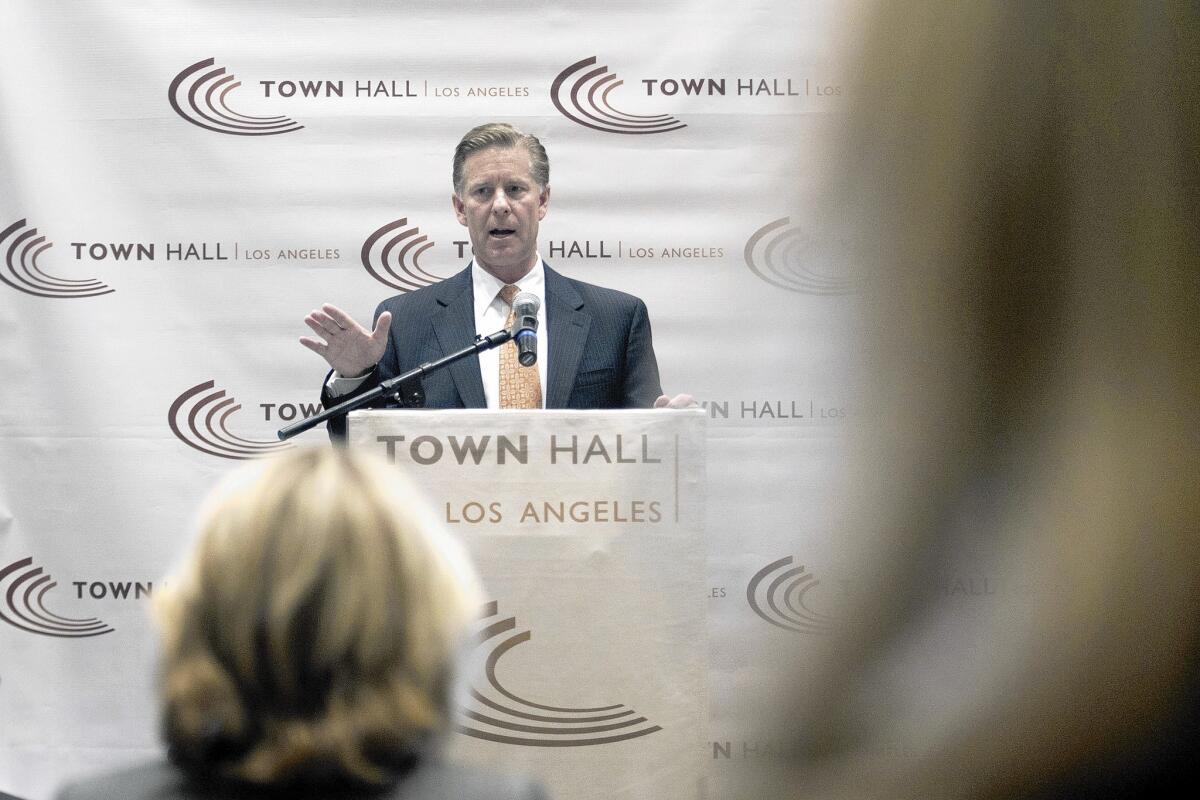Anthem’s Obamacare rates to increase less than 10% in California

In the strongest indication yet where Obamacare rates are headed, industry giant Anthem Blue Cross said its California premiums for individual coverage will increase less than 10% on average next year.
Health insurance rates in California during the initial rollout of the Affordable Care Act were better than expected, helping boost enrollment to 1.4 million people in the Covered California exchange.
But Anthem and some other insurers across the country had previously predicted double-digit rate hikes in 2015 that could hamper future enrollment and renewals when sign-ups start again in November.
In a speech Thursday at Town Hall Los Angeles, however, Anthem Blue Cross President Mark Morgan said Californians would fare better than that. He said the age and projected medical costs of new enrollees are in line with the company’s expectations thus far.
“We will not have double-digit increases in our Covered California operations,” Morgan said in his speech. “That’s a good indication of how we feel about the success of our early work, because there are other parts of the country where we are hearing 20% and higher.”
Anthem is the largest for-profit health insurer in California and the biggest company by enrollment in the state exchange. It’s a unit of industry giant WellPoint Inc., which sells Obamacare policies in California and 13 other states.
In comments after his speech, Morgan declined to be more specific about California rates since they are still subject to negotiation with state officials. He said stability is essential because “if rates go up substantially the underpinnings for affordability are shaky.”
Last week, Anthem and other insurers filed their proposed rates for 2015 with Covered California. The exchange is reviewing those premiums, and negotiations with the health plans will ensue over the next few weeks.
The final rates are expected to be disclosed publicly in late July when health insurers submit them to state regulators for review. The outcome in California will be closely watched because the state is a key barometer for the health overhaul nationwide.
Consumer advocates said the passage of the health law and Covered California’s willingness to bargain over rates were having a positive effect for consumers.
“The Obamacare doomsayers predicting double-digit increases are once again wrong,” said Anthony Wright, executive director of Health Access California, a consumer advocacy group.
Anthem led the first year of Covered California enrollment with 425,058 people through April 15, or 30% of the exchange market. San Francisco insurer Blue Shield of California was next with a 27% share. Woodland Hills insurer Health Net Inc. was third with a 19% share, and HMO giant Kaiser Permanente was fourth with 17% of Covered California’s enrollment.
A spokesman for Kaiser said it was too soon to say for sure, but “we are optimistic that rates will see only modest increases next year” in Covered California.
Blue Shield and Health Net declined to comment Thursday about future rates, citing the ongoing negotiations.
Industry experts say health plans will be jockeying for a competitive edge with insurance shoppers, and price usually comes first.
“Consumers enrolling through the exchange are extremely price sensitive and tend to focus primarily on premiums,” said Dan Mendelson, chief executive at consulting firm Avalere Health. “Plans that gained a minimal share in 2014 will naturally want to price their products more competitively in 2015.”
Outside California, proposed rates have fluctuated wildly depending on the company and market.
In the Washington state exchange, Kaiser Permanente proposed a rate increase of less than 1% for 2015, while other insurers want to raise premiums 11%. Molina Healthcare, a Long Beach-based insurer selling in California’s exchange, sought a 7% decrease in Washington.
Another key factor for next year’s rates is the size of the physician and hospital networks available to patients. Many consumers have complained about the narrower networks they had to choose from and their inability to find a preferred doctor who would be in network.
There have also been ongoing problems with the accuracy of provider lists published by Covered California and insurers.
Thursday, Morgan defended the limited size of these narrow networks as a valuable tool to get lower rates from medical providers and pass along those savings to consumers.
“These narrow networks are making a huge difference on affordability,” Morgan said. “People value price above all else.... These narrow networks are really here to stay.”
Morgan acknowledged that Anthem has made mistakes at times in giving erroneous information about its networks to both consumers and physicians, adding to the general confusion.
The three biggest insurers in the exchange by enrollment have all expanded their networks since January to help alleviate some concerns.
Anthem said it has added more than 3,800 medical providers to its statewide exchange network since January, including well-known hospitals such as Cedars-Sinai Medical Center.
Blue Shield said its PPO network for individual coverage has grown to include 64% of physicians and more than 82% of hospitals on its standard PPO roster.
Morgan said Anthem doesn’t have any firm numbers yet on how many of its California enrollees were previously uninsured. But he said the initial data point to substantial progress at reaching the uninsured.
“A large majority of the people we see in Covered California we’ve never seen before,” he said, “so directionally that suggests we are getting the previously uninsured.”
Twitter: @chadterhune







